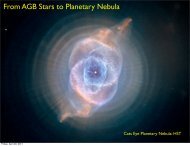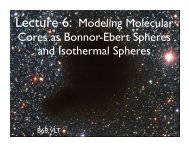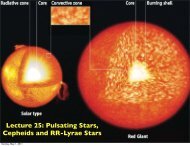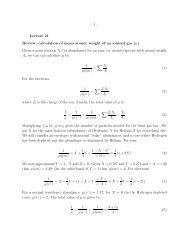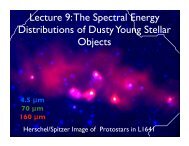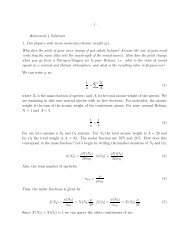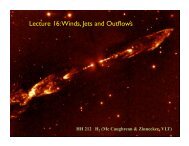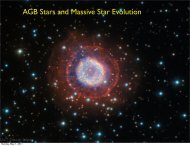Lecture 3 Properties and Evolution of Molecular Clouds
Lecture 3 Properties and Evolution of Molecular Clouds
Lecture 3 Properties and Evolution of Molecular Clouds
- No tags were found...
Create successful ePaper yourself
Turn your PDF publications into a flip-book with our unique Google optimized e-Paper software.
<strong>Lecture</strong> 3<strong>Properties</strong> <strong>and</strong> <strong>Evolution</strong> <strong>of</strong><strong>Molecular</strong> <strong>Clouds</strong>Spitzer space telescope image <strong>of</strong> Snakemolecular cloud (IRDC G11.11-0.11
The Galaxy in COThe CfA CO Survey (488,000 spectra 7’ resolutionII I IV IIIQuadrantshttp://cfa-www.harvard.edu/mmw/MilkyWayinMol<strong>Clouds</strong>.html2MASS Near-IR Survey
The OrionGiant<strong>Molecular</strong>CloudComplexTotal mass200,000 MsunCO map <strong>of</strong> Wilson et al. (2005) overlaid on image <strong>of</strong> Orion4
Cloud Mass FunctiondN/dlog(m) = kM -0.81M upper = 5.8 x 10 6 MsundN/dlog(m) = kM -0.67M upper = 5.8 x 10 6 MsunMass is weighted towardthe most massive cloudsWilliams & McKee 1997ApJ 476, 166.
Size-Linewidth RelationshipSolomon 1987 ApJ 319, 730
Are <strong>Clouds</strong> Bound?
Are <strong>Clouds</strong> Bound?
Are <strong>Clouds</strong> Bound?Larson 1981VirialBoundNote: σ is 3-D velocity distribution
Using Galactic Ring DataVirialBoundNote: alpha may beunderestimatedHeyer et al. 200912
The Stability <strong>of</strong> <strong>Clouds</strong>: Jeans InstabilityWe start with the basic equations for fluid motions:13
The Stability <strong>of</strong> <strong>Clouds</strong>: Jeans Instability14
The Stability <strong>of</strong> <strong>Clouds</strong>: Jeans Instability15
The Stability <strong>of</strong> <strong>Clouds</strong>: Jeans Instability16
The Stability <strong>of</strong> <strong>Clouds</strong>: Jeans Instability17
The Stability <strong>of</strong> <strong>Clouds</strong>: Jeans Instability18
The Stability <strong>of</strong> <strong>Clouds</strong>: Jeans Instability19
Are <strong>Clouds</strong> Stable to Fragmentation?For n(H2) = 40 cm -3 λJ = 6 pc MJ = 450 Msun (cloud size)For n(H2) = 100 cm -3 λJ = 4. pc MJ = 350 Msun (cloud size)For n(H2) = 1000 cm -3 λJ = 1.2 pc MJ = 100 Msun (clump size)Cloud masses <strong>and</strong> lengths exceed Jeans length masses.From clouds in the inner galaxy from Heyer et al. 200920
<strong>Molecular</strong> <strong>Clouds</strong> areFilamentary <strong>and</strong> ClumpyOrionUnits in ParsecsOphiuchusTaurus21
Star Formation EfficiencyTypical cloud efficiencies are a few percent for molecular cloudsFrom Evans et al. 200922
Lifetimes <strong>of</strong> Nearby <strong>Clouds</strong>
The Lifetimes <strong>of</strong> <strong>Clouds</strong>Survey <strong>of</strong> CO toward 24 Clusters: Leisawitz, Bash & Thaddeus 1989 ApJS 70, 731
5 MyrOB Associations10 Myr20 MyrUnbound groups <strong>of</strong>OB stars plus many(usually undetected)low mass stars.Near associationsinclude Sco OB2 <strong>and</strong>Orion OB1.Associations havesubgroups <strong>of</strong> differentages.Only one residual cloud in Upper ScoSubgroups with ages >5 Myr typically don’thave residual gas.Slides from Thomas Prebisch (MPIFR)1-10 Myr
Timescales• Star formation lifetime < 5 MyrStar formation timescale comparable to cloud free-fall time <strong>and</strong>larger than crossing time.t = length/σ26
A Proposed Picture for StarFormation in the Nearby Galaxy27
The Formation <strong>of</strong> <strong>Molecular</strong> HydrogenThe rate <strong>of</strong> H 2 formation in the gas phase is very low.H 2 can form on the surfaces <strong>of</strong> dust grains (from Stahler & Palla):Collision rate with grains: 1/t coll = n HI σ d V thH moves around grains through quantum tunneling, may find defect in lattice <strong>and</strong>stick. When another H comes along, the two atoms bind. Some <strong>of</strong> that energy kicksthe H 2 <strong>of</strong>f the grain.Formation rate: R H2 = 1/2 γ H n d / t coll= 1/2 γ H n d n HI σ d V thγ H is the sticking probability, n d is density <strong>of</strong> grains, n HI is density <strong>of</strong> hydrogen, σ d iscross section <strong>of</strong> grains, V th = thermal velocity <strong>of</strong> gas
Dissociation <strong>of</strong> <strong>Molecular</strong> Hydrogen1. Absorption <strong>of</strong> UV photons with energies <strong>of</strong> 4.48-13.6 ev2. The photons raises molecule to excited electronic state.3. This energy can be exchanged to vibrational <strong>and</strong> rotational modes.4. A fraction <strong>of</strong> these excited molecules will dissociate into two H.Two prevent dissociation, molecules must be shielded from UVradiation from external starlight. This is done by dust <strong>and</strong> selfshielding <strong>of</strong> the molecule.
PDRs: Photodissociation Regionsor Photon Dominated Regions from FUVRadiationSpitzer Image <strong>of</strong>Cep OB3
PDRsPhotons with13.6 ev > hϖ > 4.48 ev cannotionize H2, but can dissociate H 2D. J. Hollenbach & A. G. G. M. Tielens ARAA 35, 179
Heating <strong>and</strong> Cooling in PDRsTemperature determined by balance<strong>of</strong> heating <strong>and</strong> cooling ratesD. J. Hollenbach & A. G. G. M. Tielens ARAA 35, 179
Collapse vs CompressionHow do we create a cloud with N(H2) = 2 x 10 21 cm -3 (2 AV)3d collapse <strong>of</strong> spherical cloud1d compression <strong>of</strong> elongated cloudτ = κρ 2Rρ = M/(4/3πR 3 )τ = [κ3/(4π)]R -2τ = κρΔxρ = M/(AL)τ = kM/AThe time to collapse from an HIcloud with density <strong>of</strong> 10 cm -3Would take 6 Myr to sweep up from10 cm -3 with a 10 kms -1 motion
Converging FlowsHI flow (from bubble as example)H 2HI flow (from bubble as example)Heitsch et al. In press
Formation <strong>of</strong> Clumps (Heitsch et al. 2008 in press)
The Destruction <strong>of</strong> <strong>Molecular</strong> <strong>Clouds</strong>M16
Photoevaporative Flows due to EUV Ionizing Radiation (hν > 13.6 ev)Hester et al. 1996 AJ 111, 2349
Cepheus BubbleThe Rocket EffectGlobule Moving atup to 20 km s -1CO (1-0) mapPatel et al. 1998 ApJ 507, 241Ionized Gas Movingat up to 20 km s -1Kent Wood
Gravity also plays an important role in forming clouds39Yang et al. 2007
Summary<strong>Molecular</strong> clouds are typically massive objects with masses <strong>of</strong> 10 4 - 10 6 solar massesThey tend to follow Larson’s laws: N(H 2 ) = 1 x 10 21 cm -2 , σ = k R 0.5They tend to have approximately equal kinetic <strong>and</strong> potential energies.They are unstable to fragmentationLifetimes are a few million years, comparable to free-fall time, less than crossing time.Picture <strong>of</strong> star formation:•Gas swept up into opaque sheets.•Gravity forms filaments <strong>and</strong> clumps•Gas fragments to form stars•Stars (particularly massive stars) quickly dissipate the gas.
Sizescales100 pc < 0.1 pc10 MyrCloud complexes OB associationsTimescales1 MyrIndividual <strong>Clouds</strong>Clusters <strong>and</strong> ClumpsCores <strong>and</strong> Protostars
Supersonic Motions in <strong>Clouds</strong>Sound speed in molecular cloudsc s = (kT/m H2 ) 1/2c s = 0.35 km s -1Linewidths were a few km s -1 , thus motionsare supersonic



